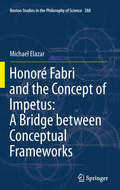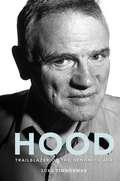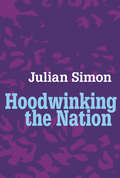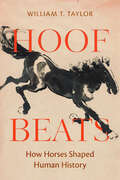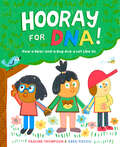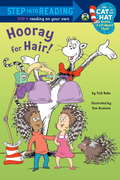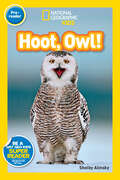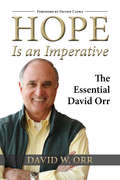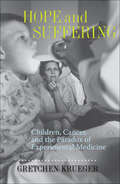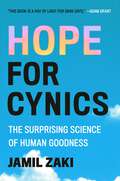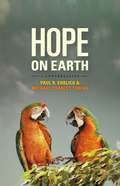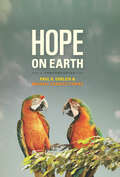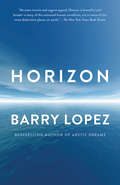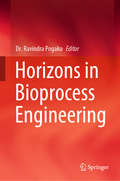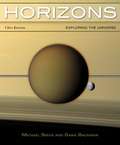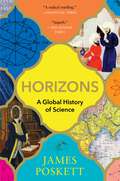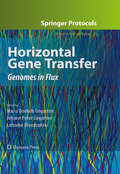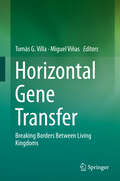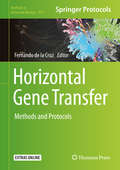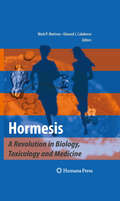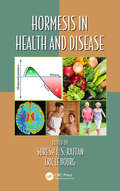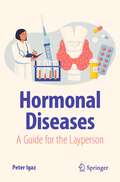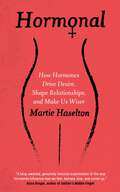- Table View
- List View
Honoré Fabri and the Concept of Impetus: A Bridge between Conceptual Frameworks
by Michael ElazarThis book discusses the impetus-based physics of the Jesuit natural philosopher and mathematician Honoré Fabri (1608-1688), a senior representative of Jesuit scientists during the period between Galileo's death (1642) and Newton's Principia (1687). It shows how Fabri, while remaining loyal to a general Aristotelian outlook, managed to reinterpret the old concept of "impetus" in such a way as to assimilate into his physics building blocks of modern science, like Galileo's law of fall and Descartes' principle of inertia. This account of Fabri's theory is a novel one, since his physics is commonly considered as a dogmatic rejection of the New Science, not essentially different from the medieval impetus theory. This book shows how New Science principles were taught in Jesuit Colleges in the 1640s, thus depicting the sophisticated manner in which new ideas were settling within the lion's den of Catholic education.
Hood: Trailblazer Of The Genomics Age
by George Church Tracy Cutchlow Luke Timmerman Robert Simison Todd Bennings<P>Lee Hood did that rarest of things. <P>He enabled scientists to see things they couldn't see before and do things they hadn't dreamed of doing. <P>Scientists can now sequence complete human genomes in a day, setting in motion a revolution that is personalizing medicine.<P> Hood, a son of the American West, was an unlikely candidate to transform biology.<P> But with ferocious drive, he led a team at Caltech that developed the automated DNA sequencer, the tool that paved the way for the Human Genome Project. <P>He captivated scientists with his almost religious fervor for the new biology enabled by the machines.<P> Hood's brilliance, rebellion, enthusiasm, and ego earned him detractors as well as admirers. <P>His management style, once described as "creative anarchy," alienated many. Some of his collaborators seethed, claiming he took too much credit. <P>Fellow Caltech biologists charged that his empire building was out of control and ousted him as their chairman. A fraud in his lab made him consider, for a moment, quitting science.<P> Wooed by money from Bill Gates, Hood started over at the University of Washington, creating the world's first Department of Molecular Biotechnology.<P> Seven years later, his impatience for rules drove him to depart.<P> He left at age sixty-one to start his own Institute for Systems Biology. Would he finally achieve the ultimate application of the genome project--personalized medicine?<P> In "Hood: Trailblazer of the Genomics Age," journalist Luke Timmerman zeroes in on a charismatic, controversial personality. Never-before-reported details are drawn from the scientist's confidential files, public records, and more than 150 interviews with Hood and his family, friends, collaborators, and detractors. The result is not just a revealing portrait of one of the most influential biologists of our time, but a deeply human look at science itself.
Hoodwinking the Nation
by Julian SimonMost people in the United States believe that our environment is getting dirtier, we are running out of natural resources, and population growth is a burden and a threat. These beliefs according to Simon, are entirely wrong. Why do the media report so much false bad news about these? And why do we believe it? Those are the questions distinguished scholar, Julian Simon set out to answer in this book.
Hoof Beats: How Horses Shaped Human History
by William T. TaylorJourney to the ancient past with cutting-edge science and new data to discover how horses forever altered the course of human history. From the Rockies to the Himalayas, the bond between horses and humans has spanned across time and civilizations. In this archaeological journey, William T. Taylor explores how momentous events in the story of humans and horses helped create the world we live in today. Tracing the horse's origins and spread from the western Eurasian steppes to the invention of horse-drawn transportation and the explosive shift to mounted riding, Taylor offers a revolutionary new account of how horses altered the course of human history. Drawing on Indigenous perspectives, ancient DNA, and new research from Mongolia to the Great Plains and beyond, Taylor guides readers through the major discoveries that have placed the horse at the origins of globalization, trade, biological exchange, and social inequality. Hoof Beats transforms our understanding of both horses and humanity's ancient past and asks us to consider what our relationship with horses means for the future of humanity and the world around us.
Hook a Fish, Catch a Mountain
by Jean Craighead GeorgeAfter catching a cutthroat, a vanishing species of fish in the Snake River, Spinner Shafter and her cousin Alligator do some ecological detecting to determine where the fish came from and how he had survived.
Hooray for DNA!: How a Bear and a Bug Are a Lot Like Us
by Pauline ThompsonBill Nye meets Green Eggs and Ham in this playful and rhythmic nonfiction picture book that introduces readers to the concept of DNA, and celebrates the similarities we share with all life-forms--and each other! <P><P> DNA is the ABC<br> of what makes you, you<br> and what makes me, me.<br> <P><P> Did you know we share DNA with every living thing? Humans, bugs, bears, even a virus—we all have shared DNA hidden inside us! <P><P> From a debut author and an award-winning illustrator, here is a bouncy and playful picture book—perfect for the classroom or for story time—about the genetic code that makes up all l
Hooray for Hair! (Step into Reading)
by Tom Brannon Tish RabeThe Cat in the Hat goes on a hairy adventure in this leveled reader for independent readers all about--what else?--hair! It's Crazy Hair Day at Sally and Nick's school, and the kids can't pick a style to wear. Curly or straight? Long or short? It's too hard to choose--until the Cat in the Hat arrives with his Wig-o-lator--a machine that allows the kids to "try on" the hairstyles of a yak, a fur seal, and a porcupine, with comical (and educational) results! Written specifically for children learning to read on their own, this Step 3 book is based on an episode of the hit PBS Kids' TV show The Cat in the Hat Knows a Lot About That! Young readers will flip their wigs over it!
Hoot, Owl! (Readers)
by Shelby AlinskyThis pre-reader uses simple vocabulary and fun pictures to capture the interest and help develop the skills of beginning readers. The humorous and fun information about one of nature's most intriguing animals makes this new reading experience a treat.
Hope Is an Imperative: The Essential David Orr
by Fritjof Capra David W. OrrFor more than three decades, David Orr has been one of the leading voices of the environmental movement, championing the cause of ecological literacy in higher education, helping to establish and shape the field of ecological design, and working tirelessly to raise awareness of the threats to future generations posed by humanity's current unsustainable trajectory. Hope Is an Imperative brings together in a single volume Professor Orr's most important works. These include classics such as "What Is Education For?," one of the most widely reprinted essays in the environmental literature, "The Campus and the Biosphere," which helped launch the green campus movement,and "Loving Children: A Design Problem," which renowned theologian and philosopher Thomas Berry called "the most remarkable essay I've read in my whole life." The book features thirty-three essays, along with an introductory section that considers the evolution of environmentalism, section introductions that place the essays into a larger context, and a foreword by physicist and author Fritjof Capra. Hope Is an Imperative is a comprehensive collection of works by one of the most important thinkers and writers of our time. It offers a complete introduction to the writings of David Orr for readers new to the field, and represents a welcome compendium of key essays for longtime fans. The book is a must-have volume for every environmentalist's bookshelf.
Hope and Suffering: Children, Cancer, and the Paradox of Experimental Medicine
by Gretchen KruegerGretchen Krueger's poignant narrative explores how doctors, families, and the public interpreted the experience of childhood cancer from the 1930s through the 1970s. Pairing the transformation of childhood cancer from killer to curable disease with the personal experiences of young patients and their families, Krueger illuminates the twin realities of hope and suffering. In this social history, each decade follows a family whose experience touches on key themes: possible causes, means and timing of detection, the search for curative treatment, the merit of alternative treatments, the decisions to pursue or halt therapy, the side effects of treatment, death and dying—and cure. Recounting the complex and sometimes contentious interactions among the families of children with cancer, medical researchers, physicians, advocacy organizations, the media, and policy makers, Krueger reveals that personal odyssey and clinical challenge are the simultaneous realities of childhood cancer. This engaging study will be of interest to historians, medical practitioners and researchers, and people whose lives have been altered by cancer.
Hope for Cynics: The Surprising Science of Human Goodness
by Jamil ZakiAmazon Editors' Pick for Best Nonfiction Books of 2024 Cynicism is making us sick; Stanford Psychologist Dr. Jamil Zaki has the cure—a &“ray of light for dark days&” (Adam Grant, #1 New York Times bestselling author). For thousands of years, people have argued about whether humanity is selfish or generous, cruel or kind. But recently, our answers have changed. In 1972, half of Americans agreed that most people can be trusted; by 2018, only a third did. Different generations, genders, religions, and political parties can't seem to agree on much, but they all think human virtue is evaporating. Cynicism is an understandable response to injustice and inequality. But in many cases, it is misplaced. Dozens of studies find that people fail to realize how kind, generous, and open-minded people really are. And cynical thinking deepens social problems: when we expect the worst in people, we often bring it out of them. We don't have to remain stuck in this cynicism trap. Through science and storytelling, Jamil Zaki imparts the secret for beating back cynicism: hopeful skepticism—thinking critically about people and our problems while honoring and encouraging our strengths. Far from being naive, hopeful skepticism is a precise way of understanding others that can rebalance our view of human nature and help us build the world we want.
Hope on Earth: A Conversation
by Paul R. Ehrlich Michael Charles TobiasHope on Earth is the thought-provoking result of a lively and wide-ranging conversation between two of the world’s leading interdisciplinary environmental scientists: Paul R. Ehrlich, whose book The Population Bomb shook the world in 1968 (and continues to shake it), and Michael Charles Tobias, whose over 40 books and 150 films have been read and/or viewed throughout the world. Hope on Earth offers a rare opportunity to listen in as these deeply knowledgeable and highly creative thinkers offer their takes on the most pressing environmental concerns of the moment. Both Ehrlich and Tobias argue that we are on the verge of environmental catastrophe, as the human population continues to grow without restraint and without significant attempts to deal with overconsumption and the vast depletion of resources and climate problems it creates. Though their views are sympathetic, they differ in their approach and in some key moral stances, giving rise to a heated and engaging dialogue that opens up dozens of new avenues of exploration. They both believe that the impact of a human society on its environment is the direct result of its population size, and through their dialogue they break down the complex social problems that are wrapped up in this idea and attempts to overcome it, hitting firmly upon many controversial topics such as circumcision, religion, reproduction, abortion, animal rights, diet, and gun control. For Ehrlich and Tobias, ethics involve not only how we treat other people directly, but how we treat them and other organisms indirectly through our effects on the environment. University of California, Berkeley professor John Harte joins the duo for part of the conversation, and his substantial expertise on energy and climate change adds a crucial perspective to the discussion of the impact of population on global warming. This engaging and timely book invites readers into an intimate conversation with some of the most eminent voices in science as they offer a powerful and approachable argument that the ethical and scientific issues involved in solving our environmental crisis are deeply intertwined, while offering us an optimistic way forward. Hope on Earth is indeed a conversation we should all be having.
Hope on Earth: A Conversation
by Paul R. Ehrlich Michael Charles TobiasHope on Earth is the thought-provoking result of a lively and wide-ranging conversation between two of the world’s leading interdisciplinary environmental scientists: Paul R. Ehrlich, whose book The Population Bomb shook the world in 1968 (and continues to shake it), and Michael Charles Tobias, whose over 40 books and 150 films have been read and/or viewed throughout the world. Hope on Earth offers a rare opportunity to listen in as these deeply knowledgeable and highly creative thinkers offer their takes on the most pressing environmental concerns of the moment. Both Ehrlich and Tobias argue that we are on the verge of environmental catastrophe, as the human population continues to grow without restraint and without significant attempts to deal with overconsumption and the vast depletion of resources and climate problems it creates. Though their views are sympathetic, they differ in their approach and in some key moral stances, giving rise to a heated and engaging dialogue that opens up dozens of new avenues of exploration. They both believe that the impact of a human society on its environment is the direct result of its population size, and through their dialogue they break down the complex social problems that are wrapped up in this idea and attempts to overcome it, hitting firmly upon many controversial topics such as circumcision, religion, reproduction, abortion, animal rights, diet, and gun control. For Ehrlich and Tobias, ethics involve not only how we treat other people directly, but how we treat them and other organisms indirectly through our effects on the environment. University of California, Berkeley professor John Harte joins the duo for part of the conversation, and his substantial expertise on energy and climate change adds a crucial perspective to the discussion of the impact of population on global warming. This engaging and timely book invites readers into an intimate conversation with some of the most eminent voices in science as they offer a powerful and approachable argument that the ethical and scientific issues involved in solving our environmental crisis are deeply intertwined, while offering us an optimistic way forward. Hope on Earth is indeed a conversation we should all be having.
Horizon
by Barry LopezFrom the National Book Award-winning writer, humanitarian, environmentalist and author of the now-classic Arctic Dreams: a vivid, poetic, capacious work that recollects the travels around the world and the encounters--human, animal, and natural--that have shaped his extraordinary life. Poignantly, powerfully, it also asks "How do we move forward?"Taking us nearly from pole to pole--from modern megacities to some of the most remote regions on the earth--Barry Lopez, hailed by the Los Angeles Times Book Review as "one of our finest writers," gives us his most far-ranging yet personal work to date, in a book that moves through decades of his life as it describes his travels to six regions of the world: from the Oregon coast where he lives to the northernmost reaches of Canada; to the Galapagos; to the Kenyan desert; to Botany Bay in Australia; and in the resounding last section of this magisterial book, unforgettably to the ice shelves of Antarctica. As he revisits his growing up and these myriad travels, Lopez also probes the long history of humanity's quests and explorations, including the prehistoric peoples who trekked across Skraeling Island in northern Canada; the colonialists who plundered Central Africa; an Enlightenment-era Englishman who sailed the Pacific and a Native American emissary who arrived in Japan before it opened to the West. He confronts today's ecotourism in the tropics and visits the haunting remnants of a French colonial prison on Île du Diable in French Guiana. Through these journeys, and friendships forged along the way with scientists, archeologists, artists and local residents, Lopez searches for meaning and purpose in a broken world. With tenderness and intimacy, Horizon evokes the stillness and the silence of the hottest, the coldest and the most desolate places on the globe. It speaks with beauty and urgency to the invisible ties that unite us; voices concern and frustration alongside humanity and hope; and looks forward to our shared future as much as it looks back at a single life. Revelatory, powerful, profound, this is an epic work of nonfiction that makes you see the world differently: a crowning achievement by one of our most humane voices--one needed now more than ever.
Horizon
by Barry LopezFrom the National Book Award-winning writer, humanitarian, environmentalist and author of the now-classic Arctic Dreams: a vivid, poetic, capacious work that recollects the travels around the world and the encounters--human, animal, and natural--that have shaped his extraordinary life. Poignantly, powerfully, it also asks "How do we move forward?"Taking us nearly from pole to pole--from modern megacities to some of the most remote regions on the earth--Barry Lopez, hailed by the Los Angeles Times Book Review as "one of our finest writers," gives us his most far-ranging yet personal work to date, in a book that moves through decades of his life as it describes his travels to six regions of the world: from the Oregon coast where he lives to the northernmost reaches of Canada; to the Galapagos; to the Kenyan desert; to Botany Bay in Australia; and in the resounding last section of this magisterial book, unforgettably to the ice shelves of Antarctica. As he revisits his growing up and these myriad travels, Lopez also probes the long history of humanity's quests and explorations, including the prehistoric peoples who trekked across Skraeling Island in northern Canada; the colonialists who plundered Central Africa; an Enlightenment-era Englishman who sailed the Pacific and a Native American emissary who arrived in Japan before it opened to the West. He confronts today's ecotourism in the tropics and visits the haunting remnants of a French colonial prison on Île du Diable in French Guiana. Through these journeys, and friendships forged along the way with scientists, archeologists, artists and local residents, Lopez searches for meaning and purpose in a broken world. With tenderness and intimacy, Horizon evokes the stillness and the silence of the hottest, the coldest and the most desolate places on the globe. It speaks with beauty and urgency to the invisible ties that unite us; voices concern and frustration alongside humanity and hope; and looks forward to our shared future as much as it looks back at a single life. Revelatory, powerful, profound, this is an epic work of nonfiction that makes you see the world differently: a crowning achievement by one of our most humane voices--one needed now more than ever.
Horizons in Bioprocess Engineering
by Ravindra PogakuThis book is divided into four parts that outline the use of science and technology for applications pertaining to chemical and bioprocess engineering. The book endeavors to help academia, researchers, and practitioners to use the principles and tools of Chemical and Bioprocess Engineering in a pertinent way, while attempting to point out the novel thoughts associated with the brain storming concepts encountered. As an example, the ability to use case studies appropriately is more important, to most practitioners.
Horizons: Exploring the Universe
by Michael A. Seeds Dana BackmanThe 13th Edition of HORIZONS means the proven Seeds/Backman approach and trusted content, fully updated with the latest discoveries and resources to meet the needs of today's diverse students.
Horizons: The Global Origins of Modern Science
by James PoskettThe history of science as it has never been told before: a tale of outsiders and unsung heroes from far beyond the Western canon that most of us are taught.When we think about the origins of modern science we usually begin in Europe. We remember the great minds of Nicolaus Copernicus, Isaac Newton, Charles Darwin, and Albert Einstein. But the history of science is not, and has never been, a uniquely European endeavor. Copernicus relied on mathematical techniques that came from Arabic and Persian texts. Newton’s laws of motion used astronomical observations made in Asia and Africa. When Darwin was writing On the Origin of Species, he consulted a sixteenth-century Chinese encyclopedia. And when Einstein studied quantum mechanics, he was inspired by the Bengali physicist, Satyendra Nath Bose.Horizons is the history of science as it has never been told before, uncovering its unsung heroes and revealing that the most important scientific breakthroughs have come from the exchange of ideas from different cultures around the world. In this ambitious, revelatory history, James Poskett recasts the history of science, uncovering the vital contributions that scientists in Africa, America, Asia, and the Pacific have made to this global story.
Horizontal Gene Transfer
by Lorraine Olendzenski Maria Boekels Gogarten J. Peter GogartenHorizontal gene transfer (HGT) events encompass processes as varied as the exchange of genetic material between microbes coexisting in the same environment, between symbiotic bacteria and their eukaryotic hosts, and the evolution of organelles by symbiosis, in which whole genomes are acquired. In Horizontal Gene Transfer: Genomes in Flux, expert researchers contribute an overview of HGT concepts as well as specific case histories that highlight the most current progress to inspire future work. Divided into three sections, the volume begins with an overview of terminology, concepts and the implications of HGT on current evolutionary thought and philosophy, and continues with methods involving computer and bioinformatics analyses of genomic data as well as molecular biology techniques for identifying, quantifying, and differentiating instances of HGT. A section of case studies follows, which provides detailed accounts of how HGT has shaped evolution across the diversity of organisms and organismal lineages. As a volume of the highly successful Methods in Molecular BiologyTM series, this work provides the kind of detailed description and implementation advice that is crucial for getting optimal results. Cutting-edge and thoroughly detailed, Horizontal Gene Transfer: Genomes in Flux examines how HGT has contributed to genome evolution and how understanding HGT impacts our ability to accurately reconstruct and comprehend the web-like evolutionary history in order to aid scientists in furthering their own research.
Horizontal Gene Transfer: Breaking Borders Between Living Kingdoms
by Tomás G. Villa Miguel ViñasThe book focuses on the evolutionary impact of horizontal gene transfer processes on pathogenicity, environmental adaptation and biological speciation. Newly acquired genetic material has been considered as a driving force in evolution for prokaryotic genomes for many years, with recent technical developments advancing this field further. However, the extent and implications of gene transfer between prokaryotes and eukaryotes still raise controversies. This multi-authored volume introduces various means by which DNA can be exchanged, covers gene transfer between prokaryotes and their viruses as well as between bacteria and eukaryotes, such as fungi, plants and animals, and addresses the role of horizontal gene transfer in human diseases. Aspects discussed also include the relevance for virulence and drug resistance development on one hand, and for the occurrence of naturally derived antibiotics and other secondary metabolites on the other hand. This book offers new insights to anyone interested in genome evolution and the exchange of DNA between the different domains of life, the genetic toolkit for adaptation and the emergence of multidrug resistant bacteria.
Horizontal Gene Transfer: Methods and Protocols (Methods in Molecular Biology #2075)
by Fernando de la CruzThis book focuses on technologies used to study horizontal gene transfer (HGT) in prokaryotes. Beginning with a section on the detection and isolation of mobile genetic elements (MGEs), the volume continues with sections concentrating on the analysis of conjugation, transformation, and transduction in HGT as well as a series of methods to analyze the adaptation and evolution of MGEs, with special attention paid to bioinformatics tools. Written for the highly successful Methods in Molecular Biology series, chapters include introductions to their respective topics, lists of the necessary materials and reagents, step-by-step, readily reproducible laboratory protocols, and tips on troubleshooting and avoiding known pitfalls. Authoritative and practical, Horizontal Gene Transfer: Methods and Protocols serves as an ideal guide to the further study of this pervasive, all-important mechanism of genetic originality.
Hormesis
by Edward J. Calabrese Mark P. MattsonThis book stems from the belief that scientists and policy makers should be guided by the most reliable predictive models available, among which the hormetic dose response model has considerable evidence to support it, is very generalizable, has a strong mechanistic foundation and can be applied in the assessment of single agents and complex mixtures. For these reasons, the hormetic model should become the default in risk assessment. This book summarizes and analyzes the various positives of hormesis in an attempt to revel hormesis as a fundamental principle of toxicology, biology, and biomedical sciences as a whole. A focused discussion of how acceptance of the hormedis based model of toxicology would affect environmental standards and clean up values is mounted. A panel of scientists has been recruited to critically evaluate the hormetic dose response model and its comparison with current default models in their individual fields, including cellular biology, evolutionary biology, gerontology, and pharmacology. In-depth investigations are provided into how biological systems respond to increasing doses of environmental toxins while attempting to understand how cells respond to stress in the contexts of aging and neurological disorders.
Hormesis in Health and Disease (Oxidative Stress and Disease)
by Suresh I. S. Rattan Éric Le BourgSome mild stresses have positive effects on survival and aging as shown in animal models. There is also a large body of research that demonstrates these hormetic effects on aging, health, and resistance to severe stresses and diseases in human beings. However, the data are dispersed in the literature and are not always interpreted as hormetic effec
Hormonal Diseases: A Guide for the Layperson (Copernicus Books)
by Peter IgazWritten by a recognized expert in the field, this accessible book acquaints the lay reader with the main features of hormonal diseases, their diagnosis and treatment. From gigantism and dwarfism to polycystic ovary syndrome, overactive thyroid and many more; it also explains what specialists in endocrinology do - and why - when diagnosing and treating patients.Each chapter gives a short introduction to the relevant hormonal disease, with information about the symptoms, diagnosis and treatment presented in an easily comprehensible question and answer format. Simple but accurate diagrams are used to visualize the information. The book clarifies important issues and helps patients to make informed decisions. Last but not least, it includes some current hot topics in endocrine practice as well as fascinating historical facts. It is a must-read for everyone interested in the fascinating world of hormones and their disorders.
Hormonal: How Hormones Drive Desire, Shape Relationships, and Make Us Wiser
by Martie HaseltonProvocative, ground-breaking and entertaining, the world&’s leading expert on sexuality and the ovulation cycle reveals the hidden intelligence of hormones.In this paradigm-shifting book, Martie Haselton explains how hormonal intelligence works - both its strengths and its weaknesses - and shows women how to track and understand their desires, fears and perceptions with a radical new understanding of the biological processes that profoundly influence our behaviour. Rigorously researched, entertaining and empowering, Hormonal offers women deep new insights into their bodies, brains and relationships, and will encourage women everywhere to embrace the genius of female biology.
